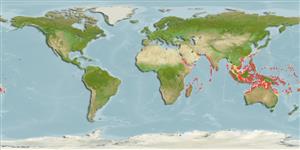Actinopterygii (ray-finned fishes) >
Clupeiformes (Herrings) >
Engraulidae (Anchovies) > Coiliinae
Etymology: Thryssa: Greek, thrissa, -es = shad (Ref. 45335).
Environment / Climate / Range
Ecology
Marine; brackish; reef-associated; depth range 0 - 50 m (Ref. 189). Tropical, preferred ?; 31°N - 25°S, 30°E - 172°W (Ref. 189)
Indo-Pacific: Red Sea to Mozambique, Madagascar and Mauritius, east to Samoa, north to the Philippine, Caroline and Mariana islands. The Ogasawara (Bonin) record seems reliable. No Indian specimens. Probably occurs in the Persian Gulf. Occurrence in Thailand (Ref. 1632) needs to be confirmed.
Size / Weight / Age
Maturity: Lm ? range ? - ? cm
Max length : 16.0 cm SL male/unsexed; (Ref. 54980); common length : 10.0 cm TL male/unsexed; (Ref. 5450)
Dorsal
spines
(total): 0;
Dorsal
soft rays
(total): 14-16;
Anal
spines: 0;
Anal
soft rays: 27 - 30. Belly rounded before pelvic fins, with 4 to 9 + 7 to 10 = 12 to 18 keeled scutes, the pre-pelvic scutes ending below the pectoral fin base or behind it. Maxilla short, reaching to just beyond front border of pre-operculum, tip pointed.
Found mostly in inshore bays, lagoons, harbors, mangrove pools and estuaries, thus apparently able to tolerate lowered salinities. Inhabits turbid waters, forming large schools (Ref. 1602). Also caught using ringnets (Ref. 5213). Used as tuna baitfish.
Life cycle and mating behavior
Maturity | Reproduction | Spawning | Eggs | Fecundity | Larvae
Whitehead, P.J.P., G.J. Nelson and T. Wongratana, 1988. FAO Species Catalogue. Vol. 7. Clupeoid fishes of the world (Suborder Clupeoidei). An annotated and illustrated catalogue of the herrings, sardines, pilchards, sprats, shads, anchovies and wolf-herrings. FAO Fish. Synop. 125(7/2):305-579. Rome: FAO. (Ref. 189)
IUCN Red List Status (Ref. 115185)
CITES (Ref. 94142)
Not Evaluated
Threat to humans
Harmless
Human uses
Fisheries: minor commercial; bait: usually
More information
ReferencesAquacultureAquaculture profileStrainsGeneticsAllele frequenciesHeritabilityDiseasesProcessingMass conversion
Tools
Special reports
Download XML
Internet sources
